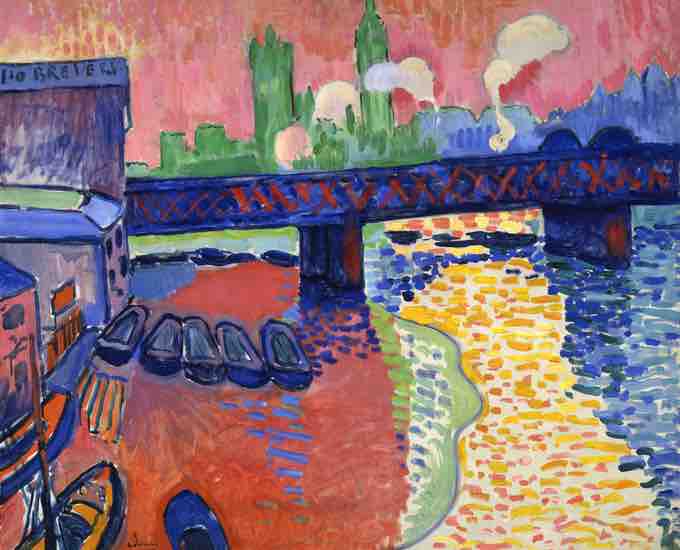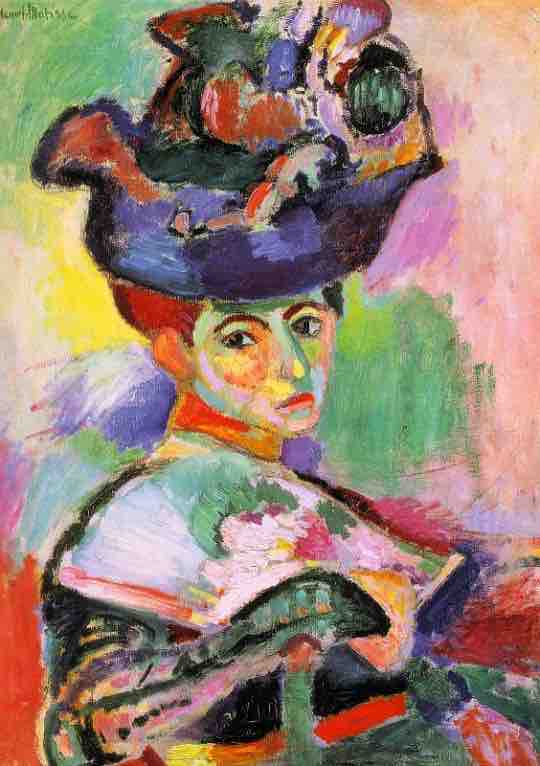Fauvism is the style of les Fauves (French for "the wild beasts"), a short-lived and loose group of early twentieth-century Modern artists whose works emphasized painterly qualities and strong color over the representational or realistic values retained by Impressionism. While Fauvism as a style began around 1900 and continued beyond 1910, the movement as such lasted only a few years, 1904–1908, and had three exhibitions. The leaders of the movement were Henri Matisse and André Derain .

"Charing Cross Bridge, London" by André Derain, 1906
The vibrant, surprising use of color in this work is characteristic of the Fauvist style.
Apart from Matisse and Derain, other artists included Albert Marquet, Charles Camoin, Louis Valtat, the Belgian painter Henri Evenepoel, Maurice Marinot, Jean Puy, Maurice de Vlaminck, Henri Manguin, Raoul Dufy, Othon Friesz, Georges Rouault, the Dutch painter Kees van Dongen, the Swiss painter Alice Bailly, and Georges Braque (subsequently Picasso's partner in Cubism).
The paintings of the Fauves were characterized by seemingly wild brush work and strident colors, while their subject matter had a high degree of simplification and abstraction. Fauvism can be classified as an extreme development of Van Gogh's Post-Impressionism fused with the pointillism of Seurat and other Neo-Impressionist painters, in particular Paul Signac. Other key influences were Paul Cézanne and Paul Gauguin, whose employment of areas of saturated color—notably in paintings from Tahiti—strongly influenced Derain's work.
Gustave Moreau, a controversial professor at the École des Beaux-Arts in Paris and a Symbolist painter, was the movement's inspirational teacher. Moreau taught Matisse, Marquet, Manguin, Rouault and Camoin during the 1890s, and was viewed by critics as the group's philosophical leader until Matisse was recognized as such in 1904. Moreau's broad-mindedness, originality, and affirmation of the expressive potency of pure color was inspirational for his students.
Derain and Matisse worked together through the summer of 1905 in the Mediterranean village of Collioure, and later that year displayed their highly innovative paintings at the Salon d'Automne. The vivid, unnatural colors led the critic Louis Vauxcelles to derisively dub their works as les Fauves, or "the wild beasts", which the artists then appropriated as the title for their movement. The painting that was singled out for special condemnation, Matisse's Woman with a Hat, was subsequently bought by the major patrons of the avant-garde scene in Paris, Gertrude and Leo Stein .

Woman with a Hat by Henri Matisse, 1905.
This painting was rejected by critics when initially exhibited, but was soon acquired by avant-garde collectors Leo and Gertrude Stein.